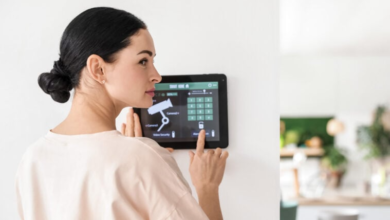Interactive Flat Panels and Teacher Efficiency: How EdTech is Reducing Prep Time and Boosting Results

The role of technology in education has evolved significantly, transforming traditional classrooms into dynamic, interactive learning environments. Among the most impactful innovations are interactive flat panel display, which have revolutionized how teachers plan, deliver, and manage lessons. These versatile, touch-enabled displays are helping educators save valuable prep time while enhancing student engagement and improving learning outcomes. Here’s how interactive flat panels are making teaching more efficient and boosting results in today’s classrooms.
The Efficiency Dilemma in Modern Teaching
Teachers are constantly balancing multiple demands—preparing engaging lessons, managing classroom dynamics, assessing student performance, and adapting to diverse learning needs. Traditional teaching tools, like chalkboards, whiteboards, and projectors, often create inefficiencies that slow down the teaching process. Preparing a single lesson can involve juggling various technologies, searching for resources, and manually creating materials, all of which consume time that teachers could otherwise spend on direct student interaction.
Interactive flat panels provide a solution by integrating the capabilities of several devices into one streamlined tool. With IFPDs, teachers can quickly access resources, present multimedia content, and interact with students in ways that traditional methods cannot match. Here’s how interactive flat panels are enhancing teacher efficiency and transforming education:
1. Centralized Access to Teaching Resources
One of the key ways interactive flat panels improve teacher efficiency is by centralizing access to teaching resources. IFPDs serve as an all-in-one hub where teachers can pull up lesson plans, multimedia content, interactive simulations, and educational apps directly on the screen. This integration eliminates the need to switch between devices or spend time setting up equipment, significantly reducing prep time.
For example, a math teacher can quickly display an interactive graphing tool, annotate on it, and adjust equations in real-time—all without leaving the panel. The seamless access to a range of digital tools allows teachers to create rich, interactive lessons on the fly, enhancing both lesson quality and delivery speed. By reducing the number of steps needed to prepare and execute lessons, IFPDs streamline the teaching process, allowing educators to focus more on engaging with their students.
2. Time-Saving Interactive Lesson Delivery
Interactive flat panels enable teachers to deliver lessons more interactively and efficiently. Teachers can present their lessons using the panel’s touchscreen interface, annotate directly on slides, and make real-time adjustments based on student feedback. This level of interactivity not only makes lessons more engaging but also reduces the need for lengthy explanations, as visual aids and direct manipulation of content can make complex concepts easier to understand.
For instance, during a science lesson, a teacher can display a 3D model of the human body on the panel, allowing students to explore different systems by zooming in, rotating, and labeling parts. This visual and hands-on approach saves time compared to traditional methods of explaining through static images or text alone. The ability to adapt and interact with content on the panel enables teachers to deliver lessons more effectively, enhancing both teaching speed and student comprehension.
Read also: How Anker’s Docking Stations Prepare You for Next-Gen Tech
3. Automated Assessments and Instant Feedback
Assessing student understanding and providing feedback are critical components of teaching, but they can also be time-consuming. Interactive flat panels simplify this process with built-in tools for creating quizzes, polls, and other formative assessments directly on the display. These assessments can be automatically graded, giving teachers immediate insights into student performance.
For example, a teacher can conduct a quick quiz on a literature lesson using the panel’s interactive capabilities. Students can respond in real-time, and the results are displayed instantly, allowing the teacher to provide feedback and address misunderstandings on the spot. This automation saves valuable time on grading and allows teachers to adapt their instruction immediately based on student needs, enhancing the learning experience without adding to the teacher’s workload.
4. Efficient Classroom Management and Organization
Interactive flat panels also improve classroom management by consolidating multiple tools into one device. Teachers can use the panel to manage lesson flow, switch seamlessly between presentations, videos, and interactive activities, and keep the class organized and on track. This streamlined approach reduces downtime between activities, keeps students focused, and maximizes instructional time.
For instance, in a history lesson, a teacher can quickly transition from a video on World War II to a digital timeline activity without needing to change devices or wait for projectors to warm up. The IFPD’s intuitive interface allows for smooth transitions, keeping the lesson dynamic and engaging. This efficient management of classroom resources helps teachers maintain a steady pace, minimizing interruptions and maximizing the impact of each lesson.
5. Reducing the Need for Printed Materials
Interactive flat panels reduce the reliance on printed materials, cutting down on prep time and associated costs. Teachers can present information, display worksheets, and conduct activities directly on the panel, eliminating the need to print, distribute, and collect paper copies. This shift not only saves time but also supports a more sustainable, eco-friendly approach to teaching.
For example, during a math class, a teacher can display a worksheet on the panel and work through problems interactively with the students. Students can follow along on their own devices or solve problems directly on the screen, making the lesson more engaging and participatory. By reducing the dependency on printed materials, teachers can streamline their prep processes and focus on creating interactive, student-centered learning experiences.
Conclusion: A Game-Changer for Teacher Efficiency
Interactive flat panels are transforming the classroom by making teaching more efficient, interactive, and effective. By centralizing resources, streamlining lesson delivery, automating assessments, enhancing classroom management, and reducing the need for printed materials, IFPDs empower teachers to maximize their time and boost student engagement. These panels not only make lesson planning and delivery faster but also create more dynamic and engaging learning environments that benefit both teachers and students.
For school districts looking to enhance educational outcomes and support their teachers, investing in interactive flat panels is a strategic move. By leveraging the power of this technology, educators can reduce prep time, improve lesson quality, and focus more on what truly matters—helping students succeed. Interactive flat panels are not just a tool for teaching; they are a catalyst for a more efficient, impactful, and future-ready classroom.



